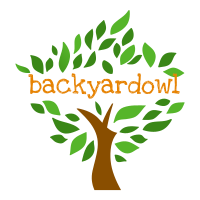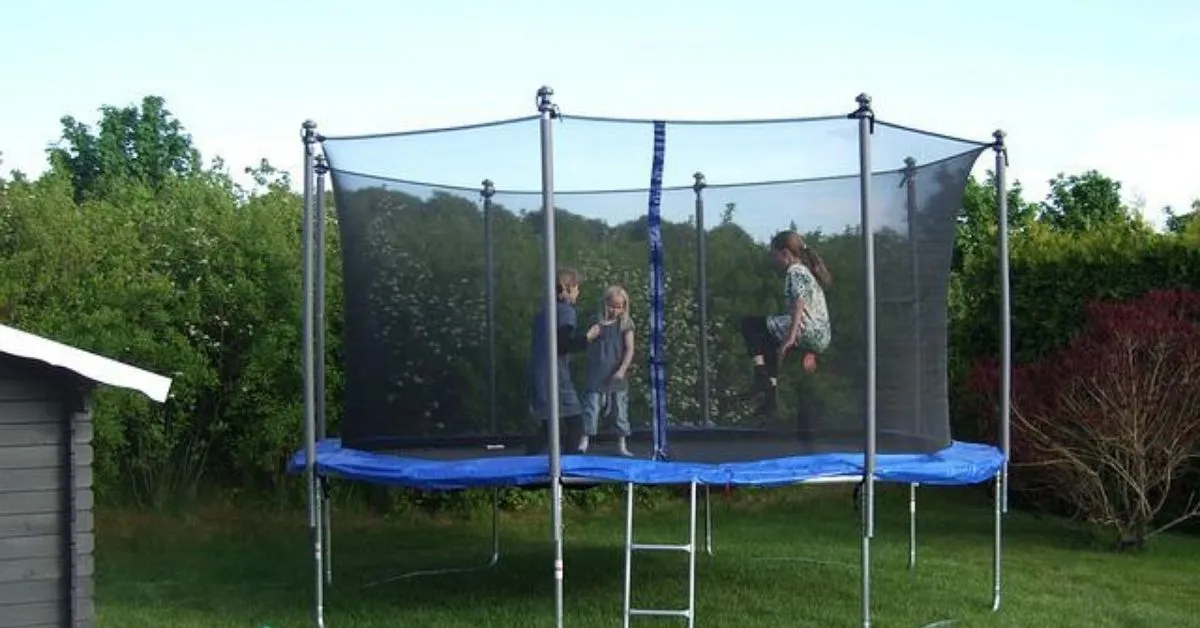It’s crucial to take into account the backyard’s surroundings and landscaping while installing a trampoline for a nice appearance. Surely, you must consider the location of nearby trees and huge shrubs as well as how much open space you will need surrounding your trampoline, but the trampoline’s base shouldn’t be neglected.
In addition to these, the trampoline foundation needs to be sturdy enough to prevent it from sinking into the ground while you jump on it. In order to keep the trampoline from sinking and to ensure a secure and appropriate bounce, you must make the trampoline’s ground base robust enough.
Many individuals just set their trampoline smack dab in the middle of their backyard, right on top of the grass, without giving any attention to ground leveling, supports sinking into the ground, or the possible harm the trampoline can and will cause to existing turf and any neighboring landscaping. This is a common mistake.
What should I place under a trampoline then? There are numerous choices, including sand, artificial grass, rubber mulch, wood chips, and many more. Here, we’ll go through the eight ideal items to put below your trampoline, along with their advantages and disadvantages. Let’s continue!
Contents
What is best to put under a trampoline? 8 Trampoline Landscaping Ideas:
Here, we’ll go over 8 different types of trampoline bases you may use to provide a safe surface for your trampoline. Let’s begin!
-
Using Rubber Mat:
Ever seen rubber mats below trampolines? Rubber mats can be positioned all around your trampoline to provide a cushioned, springy surface. Rubber mats are available in a variety of sizes.
A lot of people use interlocking mats. By simply connecting one mat to another, you can easily raise their height and length because they are sufficiently thick.
They don’t need any ground preparation, just a fast leveling of the yard, and they are also incredibly economical. They work well on steep or uneven surfaces as well.
The majority of rubber mats are also highly strong when used outside. However, before you buy them, you should check to see if they are rated for use in outdoors.
Merits
- Simple to install the mat
- Material with a reasonable price
De-Merits
- The color might not be that impressive.
-
Using Artificial Grass Mat:
Under the trampoline, beautiful landscaping can be created with artificial grass, and the trampoline will also benefit from its soft padding. The grass carpet under the trampoline will enhance your mood if you value aesthetics. The best feature is how simple it is to install and maintain this artificial grass. Under the mat, little plants can grow, but they are unable to erupt. Its durability is also valued.
With artificial grass, you won’t have to relocate your trampoline and it won’t require any care. You’ll get a little cushion from the synthetic grass or grass mat when people jump on the trampoline.
But compared to other materials used as a trampoline’s foundation, the price of the rubber grass mat is higher. A 15-foot square trampoline will cost about $400.
Merits:
- Easy to install and maintain.
- Provides a beautiful and aesthetic outlook
De-Merits:
- Costly than other options available.
-
Using Play Sand:
When there isn’t enough grass to cover the trampoline, sand is a fantastic alternative for flooring. You may create a desert scene and some protection for children who fall from the trampoline by putting sand on the trampoline bottom.
Sand, however, has some drawbacks that make it less safe than other options. Sand is easily tracked during bouncing, which is unsafe. In rare situations, chronic exposure to sand may harm the lungs. Sand might also be used by animals as a bathroom.
Sand costs about $5 per bag if you decide to add more after buying. To your knowledge, one sandbag can fill a space measuring half a cubic foot. So, to fill the area with sand for a 14-foot trampoline, you would need almost 80 sandbags, which would cost $400.
Merits:
- a longer-lasting and durable option
- Easy to use and maintain
De-Merits:
- Not particularly bouncy
- Can Be Harmful
-
Using Rubber Mulch
We strongly advise choosing rubber mulch if you want to make sure that you land safely and softly on the trampoline. It offers excellent shock resistance. You may be aware that rubber mulch is now commonly used to cover football fields and playgrounds.
Since rubber mulch deteriorates gradually and doesn’t allow for the growth of mold, it lasts longer. This flexible and springy trampoline base material offers the perfect foundation for the trampoline and its borders. The dark tint of the rubber mulch resembles that of the dark wood mulch.
So, if someone asks you what the ideal surface is for a trampoline, what would you say? Without a doubt, you might advise him or her to choose rubber mulch as the trampoline’s base material to enjoy the ideal experience.
Merits:
- Provides Soft Floor
- It is Long Lasting option
De-Merits
- Digging holes in the ground is essential.
- Expensive
-
Using Wood Chips
There are among the least expensive items to place under the trampoline. The main things that make wood chips stand out are their accessibility and cost. Each bag of wood chips costs between $3 and $5, and one bag easily covers 2 cubic feet.
As a result, wood chips can be used to cover the base of a trampoline for less than $100. There are, however, a number of pricey varieties of wood mulch that cost $150 or even more.
These are among the least expensive items to place under the trampoline. The main things that make wood chips stand out are their accessibility and cost. Each bag of wood chips costs between $3 and $5, and one bag easily covers 2 cubic feet. As a result, wood chips can be used to cover the base of a trampoline for less than $100. There are, however, a number of pricey varieties of wood mulch that cost $150 or even more.
For a low-cost but effective trampoline surface, nothing beats wood chips or bark. Just pick the appropriate shade mulch if you live in a forested location, and this will improve aesthetics.
Additionally, wood mulch absorbs some shock, which increases safety if jumpers land on the ground. Apply wood chips to a depth of at least 12 inches for the greatest results.
The trampoline can be simply covered with wood chips, but they are not as soft and springy as rubber mulch or sandbags.
Remember that wood mulch could draw insects and other pests. Moreover, there is a chance that germs and mold will grow in the soil.
Merits:
- An economic and affordable options
- Easily Available everywhere
De-Merits:
- less springy than rubber
- Possibility of drawing insects
-
Using Gymnastic Mats
The area around and beneath the trampoline can be covered with gymnastics mats. These workout mats are typically used as padding on top of hard surfaces.
These mats are ideal if your trampoline foundation is grass but you need additional fall protection. The lawn won’t be harmed by them. They are simple to fold for transport and storage.
Gymnastics mats are a little more expensive than grass, bark, or sand for trampoline bases. Although their bright colours might not blend in well with the surroundings, they do a good job of providing protection.
The majority of them aren’t intended to be used outdoors for an extended period of time because they can be damaged by sunshine or other severe environmental factors. So, following each jumping exercise, you can bring mats inside.
Merits:
- Do not harm the grass.
- Really cushiony and comfortable
De-Merits:
- little expensive
- Not really attractive
-
Bury the Trampoline:
If you’re looking for a different way to use your trampoline, burying it would be a wacky idea. The trampolines at ground level offer a wonderful view and safety.
Depending on your trampoline, you will need to dig a sizable hole before placing the trampoline there. Due to the need to prepare the pit and construct the retaining wall, it could be fairly expensive for certain homeowners, but it is still worthwhile.
The legs of the trampoline will be buried once it is installed, giving the garden a lovely appearance. For additional protection, you can install a side net.
A few disadvantages also exist. Children or animals might easily fall under a trampoline if the springs break loose, and jumping in such a condition can badly hurt the child or animal beneath.
An in-ground trampoline requires a lot of work to install. However, you can easily engage experts to complete the task.
Merits:
- Wonderful outlook
- Safe for everyone
De-Merits:
- Expensive Option
-
Using Foam Pads
Foam pads are an excellent choice to consider if you are looking for relatively inexpensive padding that can be placed on the ground just below the trampoline. They are gentle, and a wide range of hues is offered for selection. However, it’s possible that they don’t carry as much weight as the other choices.
Merits:
- Affordably priced and soft
- There is a wide range of colors available.
De-Merits:
- Cannot bear the burden of the huge load.
How Do You Prepare The Ground For A Trampoline? -FAQS
-
How to mow under a trampoline?
Due to a height restriction, mowing underneath a trampoline is different from mowing normally. But the answer is there. You may simply accomplish that with the mower’s folding handle. You could also do that by hand, using scissors or other hand-cutting tools.
-
Is it safe to put a sprinkler under my trampoline?
No, for safety reasons, it is not a great idea to place the sprinkler under the trampoline. Someone could get hurt if they jump too far, just like the heavy tumblers, and hit the sprinkler. It might shatter even if one touches the sprinkler. Therefore, don’t put the sprinkler underneath the trampoline. However, avoid moving the trampoline over the sprinkler if you frequently move it.
-
Can I use the under-trampoline space as storage?
You can do it, of course. However, for safety purposes, make sure there is a minimum of one-foot gap between the trampoline mat and any stored things.
-
Does a trampoline need to be on a flat surface?
On uneven ground, trampolines can be placed. It is feasible to place a trampoline on a hill or slope, albeit modifications to the installation procedure are required. Anchor the higher trampoline legs into the ground if the slope is only slight.
Final Thoughts:
We think that after reading the post, you now understand what to put under a trampoline and what the finest material is for that. But we strongly advise either burying the trampoline or setting it up on bark, wood mulch, artificial turf, rubber mat, gymnastics mats, or a combination of these.
For safe trampoline jumping, a solid base is essential.
Make a sturdy trampoline base now by selecting a pleasant and secure trampoline floor material. Take advantage of a beautiful trampoline floor and a safe trampoline.
We are looking forward to expanding our knowledge with the information you share. Let’s play some enjoyable games on your trampoline.

